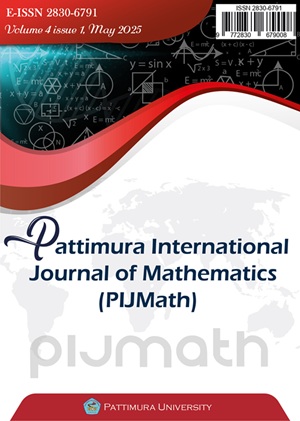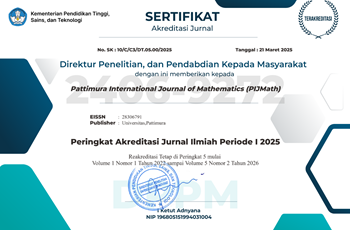Monte Carlo-Expected Tail Loss for Analyzing Risk of Commodity Futures Based on Holt-Winters Model
Abstract
Future, an agreement to buy or sell an asset at a certain price and a certain time in the future, is one of the market derivatives because the underlying assets influence the price of futures. In general, futures divide into financial futures and commodity futures. Each of the futures has different risks, so risk measures are needed to improve the effectiveness and efficiency of investment management. For example, we have the London Metal Exchange (LME) in the metal scope of commodity futures. Therefore, we propose the Holt-Winters Model for estimating commodity prices in this study. Hereafter, The Expected Tail Loss (ETL) with Monte Carlo process will use to analyze risk measures. We took six commodity futures in LME to implement the method as a sample, such as Zinc, Lead, Aluminum, Copper, Nickel, and Tin. Based on the analysis, each commodity has a different mean ETL value, where Nickel has the most significant risk with an ETL value of 0.036. This value means that the possibility of the expected loss to be borne by investors is 3.6%.
Downloads
References
T. A. Hieronymus, "Economics of futures trading: For commercial and personal profit", Ceres Books LLC: USA, 2023.
J. B. Bonnier, "Speculation and informational efficiency in commodity futures markets", Journal of International Money and Finance, vol. 117, pp. 102457, 2021.
R. H. Hoyle, "Forward and Futures Markets," in International encyclopedia of the social sciences, 2nd edition, Macmillan Reference USA, 2008, pp. 1573-1574.
O. Renn, "Risk governance: coping with uncertainty in a complex world", Routledge, 2017.
G. O. Siswono, W. H. Saputra, V. Pricila, and Y. A. Lina, "Application of holt-winter and grey holt-winter model in risk analysis of United States (US) energy commodities futures using value at risk (VaR) ", in AIP Conference Proceedings, vol. 2877, no. 1, 2023.
D. Settembre-Blundo, R. González-Sánchez, S. Medina-Salgado and F. E. García-Muiña, "Flexibility and resilience in corporate decision making: a new sustainability-based risk management system in uncertain times", Global Journal of Flexible Systems Management, 22(Suppl 2), pp. 107-132, 2021.
E. Paparoditis Efstathios and D. N. Politis, "The asymptotic size and power of the augmented Dickey-Fuller test for a unit root," 2016.
D. A. Dickey and W. A. Fuller, "Distribution of the estimators for autoregressive time series with a unit root," Journal of the American statistical association, vol. 74, no. 366a, pp. 427-431, 1979.
C. C. Holt, "Forecasting trends and seasonal by exponentially weighted moving averages," ONR Memorandum, vol. 52, no. 2, 1957.
P. R. Winters, "Forecasting sales by exponentially weighted moving averages," Management science, vol. 6, no. 3, pp. 324-342, 1960.
B. Arputhamary and L. Arockiam, "Performance Improved Holt-Winter's (PIHW) Prediction Algorithm for Big Data Environment," International Journal on Intelligent Electronics Systems, vol. 10, no. 2, 2016.
D. C. Montgomery, C. L. Jennings and M. Kulahci, "Introduction to time series analysis and forecasting", John Wiley & Sons, 2015.
Z. Drezner, O. Turel and D. Zerom, "A modified Kolmogorov-Smirnov test for normality," Communications in Statistics—Simulation and Computation®, vol. 39, no. 4, pp. 693-704, 2010.
I. M. Di Asih and A. Purbowati, "Pengukuran Value at Risk pada Aset Tunggal dan Portofolio dengan Simulasi Monte Carlo," Media Statistika, vol. 2, no. 2, pp. 93-104, 2009.
M. R. Driels and Y. S. Shin, "Determining the number of iterations for Monte Carlo simulations of weapon effectiveness," Naval Postgraduate School Monterey Ca Dept of Mechanical and Astronautical, 2004.
W. H. Saputra, D. D. Prastyo, and H. Kuswanto, "Machine Learning Modeling on Mixed-frequency Data for Financial Growth at Risk", Procedia Computer Science, vol. 234, pp. 397-403, 2024.
W. Oberle, "Monte Carlo simulations: number of iterations and accuracy," Army Research Lab Aberdeen Proving Ground MD Weapons and Materials Research, 2015.
Y. A. Lina, W. H. Saputra and V. Pricila, "Risk analysis of Jakarta composite index using value at risk and expected shortfall based on principal component regression", in AIP Conference Proceedings, vol. 2633, no. 1, 2022.
M. Airouss, M. Tahiri, A. Lahlou and A. Hassouni, "Advanced Expected Tail Loss Measurement and Quantification for the Moroccan All Shares Index Portfolio," Mathematics, vol. 6, no. 3, p. 38, 2018.
A. Carol, "Market risk analysis: Value at risk models," England, John Wiley and, 2008.
J. Hull, C. Godlewski and M. Merli, Gestion des risques et institutions financières, Pearson Education France, 2010.
Y. Yamai and T. Yoshiba, "On the validity of value-at-risk: comparative analyses with expected shortfall," Monetary and economic studies, vol. 20, no. 1, pp. 57-85, 2002.
N. Nurhasanah, J. Saputra and Y. Hidayat, "Modeling of Modified Value-At-Risk for the Skewed Student-T Distribution," Opcion, vol. 35, no. 89, pp. 932-957, 2019.
U. Azmi, G. O. Siswono, W. H. Syaifudin, W. H. Saputra, and P. M. A. Ningtyas, "Risk analysis on agricultural commodity portfolio using Value at Risk (VaR) and Expected Shortfall (ES) based on ARIMA-GARCH", in AIP Conference Proceedings, vol. 2641, no. 1, 2022.
Copyright (c) 2025 Wisnowan Hendy Saputra

This work is licensed under a Creative Commons Attribution-NonCommercial 4.0 International License.
The author(s) hold the copyright of the published article without restriction. This policy means that the journal allows the author(s) to hold and retain publishing rights without restrictions.
The author(s) holds the copyright of published articles without limitation. This policy means that the journal allows the author to hold and retain publishing rights without restrictions. Journal editors are given the copyright to publish articles in according to agreement signed by the author and also include statement of originality of the article


.jpg)












 This work is licensed under a
This work is licensed under a 